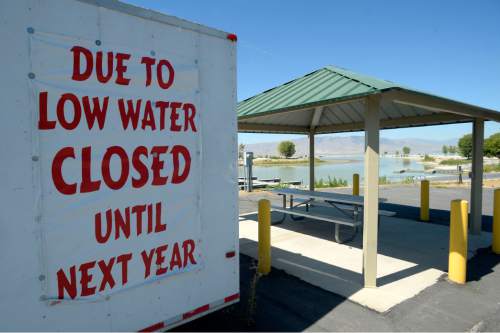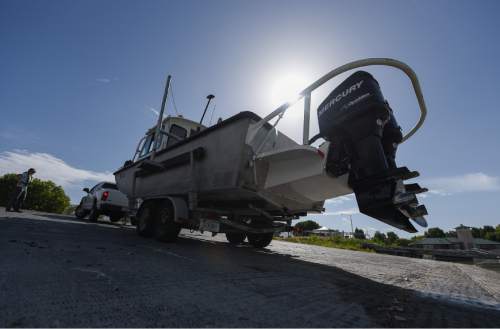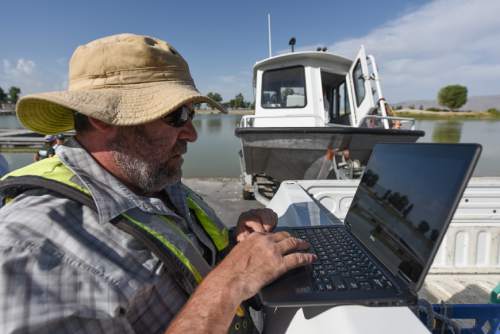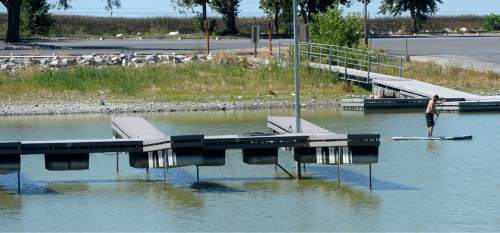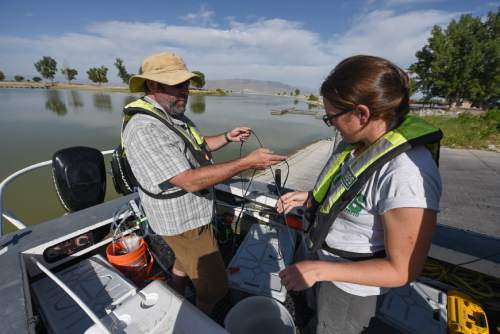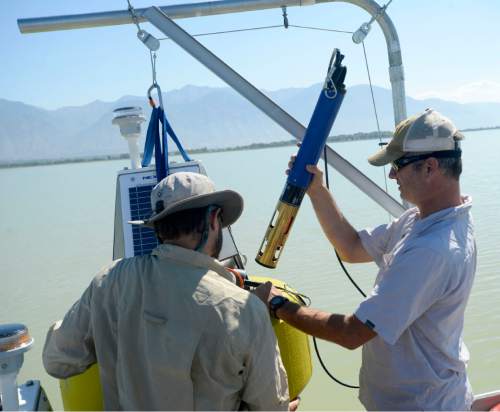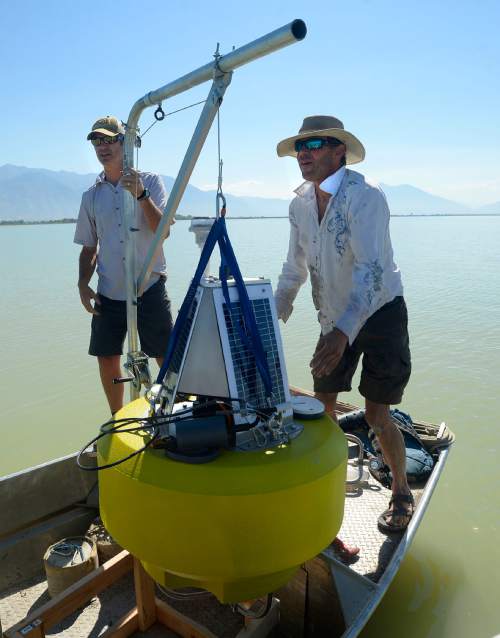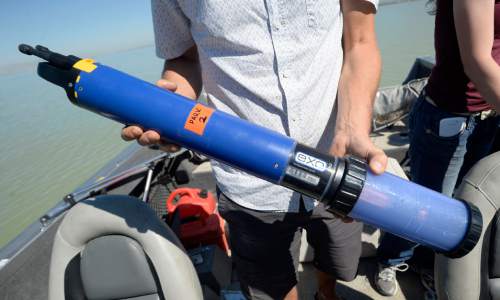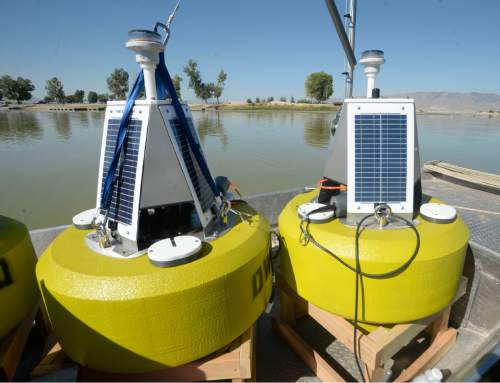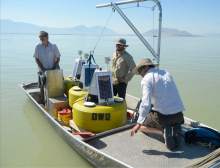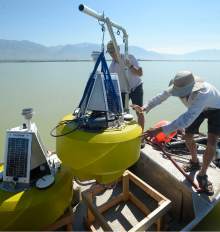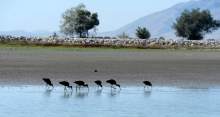This is an archived article that was published on sltrib.com in 2016, and information in the article may be outdated. It is provided only for personal research purposes and may not be reprinted.
Editor's note: This is the first in a series of stories exploring water-quality issues along the Wasatch Front.
By the time Walt Baker, director of the state Division of Water Quality, got the July 14 call about algae in Utah Lake, the bloom already had been visible from overhead satellites for at least three days.
The next day, test results indicating high concentrations of potentially toxic cyanobacteria prompted the Utah County Health Department to order the lake's closure. By July 17, warning signs dotted some 40 miles of the Jordan River's path through Utah and Salt Lake counties, and residual effects remain more than a month later.
It was, according to state officials, the largest documented algal bloom in Utah history. Yet its appearance did not come as a surprise to those familiar with the Utah Lake system, which has been used to dispose of some of civilization's least-desirable byproducts for decades.
The state holds that cleaning up this waste is the path of least resistance if Utah wants to stop the algae problem from worsening. Other experts are less convinced, pointing to theories that suggest the problems on Utah Lake, the Jordan River and the Great Salt Lake are far more complicated — even an effect of climate change.
And the state's latest efforts to verify whether its solution will work, some say, may do little more than muddy the waters.
—
How to bake an algal bloom • There is a recipe that leads to the growth of an algal bloom, said Paul "Skip" Price, an assistant research professor at Brigham Young University who has built a base of knowledge about algal blooms while studying nitrogen fertilization.
Cyanobacteria, species of bacteria generally called blue-green algae because they behave like their forest-green neighbors, are naturally present in most bodies of water. When water is warm and stagnant, and sunlight and nutrients are abundant, the potentially toxic species will begin to multiply much more rapidly than usual.
Some algal blooms occur naturally — there are fossil records, Price said, that indicate algal blooms occurred periodically in the western U.S. long before humans arrived on the scene.
LaVere Merritt, a professor emeritus who studied algal blooms — and specifically algal blooms on Utah Lake — on and off during his 40-year career at BYU, said lakes at the bottom of a valley tend to accumulate a lot of naturally nutrient-rich debris, like leaf litter. If such lakes are also shallow and located in warm climates, they may periodically experience algal blooms without much human interaction.
Utah Lake matches that profile — plus it has been the recipient of decades of sewage.
Utah's early cities were built with rudimentary systems that conveyed sewage to the nearest river for disposal; Utah had no wastewater treatment plants before the 1940s, according to a short history written by Calvin Sudweeks, a longtime water-quality manager for the state.
On the Wasatch Front, Baker said, that made Utah Lake and the Jordan River the endpoint for many pioneering wastewater systems. Utah Lake water flows via the Jordan River into the Great Salt Lake, which has no natural outlet beside evaporation — making it the final resting place for much of the surrounding area's waste, including sewage.
Today, about 71 percent of Utah's effluent — treated sewage — ultimately ends up in the Great Salt Lake. Upstream, about 13.5 percent of the water in Utah Lake comes from wastewater treatment plants, according to the latest count in 2010.
The current projection — assuming all other factors remain constant — is that as Utah County continues to grow, effluent discharge will account for more than a quarter of all the water flowing into Utah Lake by 2050, Baker said.
He believes addressing this trend is the first step to limiting algal growth on Utah Lake.
"Something needs to be done," he said. "In our belief, that something is to stem the source of food for the algae and remove nutrients from Utah Lake to a greater degree."
State and federal regulations prohibit discharge of untreated sewage — but there are no federal limits on the nutrient content of effluent. The Environmental Protection Agency has declined to pass such rules, instead indicating that the states should develop site-specific standards.
"Some states have done that with more urgency than other states," Baker said. "Larger states have more resources; some small states haven't done anything."
Utah has been working to develop nutrient standards for the past six years. The first of those standards, which will apply to key headwaters and streams that feed into Utah's larger waterways, should be unveiled next spring, Baker said. But standards for Utah Lake, the Jordan River and the Great Salt Lake are still a ways off. Baker said he doesn't expect to see a site-specific standard for Utah Lake before a $1 million study of Utah Lake — which obtained funding in late August — is complete in 2020. The Jordan River and the Great Salt Lake aren't considered priorities for standards development; waters that provide drinking water take precedence.
The state does have a technology-based limit related to phosphorus, which requires wastewater-treatment plants to install technologies that remove phosphorus by 2020. That requirement should cut the amount of phosphorus discharged from wastewater0treatment plants into Utah waters by two-thirds, Baker said. But some aren't convinced nutrient limits are the best means to control algae in Utah Lake.
—
Climate change at play • To get to the point of starving the algae into submission, Merritt believes Utah would have to prevent about 95 percent of the phosphorus currently flowing into Utah Lake — from all sources, not just wastewater — from getting there. And that, he said, would be effectively impossible.
Utah Lake contains a natural nutrient load large enough to support massive algal blooms all the time, and yet these blooms don't have a constant presence in the lake — leading Merritt to believe something else is setting them off.
Merritt said toxic algal blooms occur on Utah Lake every couple of years, following a sequence of events kicked off by low lake levels.
In July, the drainage basin that encircles the Great Salt Lake, the Jordan River and Utah Lake received 18 percent of the rainfall it typically gets that month. As of late August, Utah Lake had shrunk to 37 percent of its capacity, according to the Central Utah Water Conservancy District, leaving the lake with an average depth of about 2.5 feet.
If the lake is shallow enough when Utah experiences an extended period of hot, dry weather, Merritt said, the calm conditions not only heat up the lake, but also allow sediment that is usually suspended in the water to sink to the bottom. This lets sunlight penetrate deeper into the lake, triggering the beginnings of an algal bloom.
These days, the weather isn't exactly doing what it used to, Price said.
"In my mind, as a scientist, the evidence is very clear that climate change is occurring," he said, "and that the stabilized high temperatures in the region could be an effect of climate change."
Generally, Baker said, it takes a whole summer's worth of hot weather to heat up a lake to the point where an algal bloom can occur. He would expect algal blooms to occur in September or early October — not July.
According to the National Weather Service, the month preceding the Utah Lake algal bloom was the hottest June that Utahns have ever seen. July, by month's end, was the fourth hottest.
So were humans responsible for July's algal bloom — or was it all part of a natural phenomenon?
Price said his jury is still out, though he believes humans, and locals in particular, probably did play a role. Merritt thinks probably not, though he says that doesn't mean humans haven't caused trouble for the lake.
In Baker's mind, there's no doubt. And it's not just one or two people at fault, he says — it's all of us.
"This is not Mother Nature doing what Mother Nature does," he said. "There have been blooms before. But what we are seeing is unprecedented. ... It could be the new normal, but from my point of view, this is a problem that we need to collectively own up to."
—
Will funding dry up? • Another difficulty facing Utah Lake is the dearth of scientific research on the system.
Utah Lake was the subject of a great deal of scientific inquiry in the early 2000s, Baker said, when monitors detected elevated levels of phosphorus, salts and a specific pollutant: an organic chlorine compound known as PCB. The state considered establishing a Total Maximum Daily Load (TMDL), which would place limits on how much of a certain pollutant is allowable within a given waterway and would identify required reductions from nearby sources.
But over time, the salts were discovered to be natural and the PCB went away on its own, leaving only the elevated phosphorus levels.
In 2007, Baker said, the Division of Water Quality decided to put the TMDL development on hold to allow other state agencies to deal with invasive species in the lake.
This pattern of events has been an ongoing problem for the lake, Merritt said. Research projects start, then grind to a halt, amounting to little more than short-term data collecting that fails to illuminate the root of Utah Lake's long-term problems.
Merritt fears that will be true of the state's current million-dollar initiative. He expects this effort, like so many others, will result in "a peak of interest and then a valley of nothing."
Leland Myers, who has researched algal blooms in Farmington Bay on the Great Salt Lake while managing the Central Davis Sewer District, said if the state wants to understand Utah Lake, it needs to invest $5 million. Maybe $10 million.
This "$1 million will help you," he said, "but it won't get you there."
This kind of funding is unheard of in Baker's world, where the budget for ongoing operations related to algal blooms — excepting various grants and one-time appropriations — is currently zero.
It's not that the Division of Water Quality is underfunded, Baker said. Between state and federal funds, the division has a $10.8 million operating budget. But a lot of that money already is tied up with other designated purposes, Baker said, and the division can't deploy secretaries and accountants to collect algae samples.
During the past two years, Baker said, he has tried unsuccessfully to procure funding from the Legislature for equipment that would be capable of providing the division with a 24-7 stream of data about various conditions in Utah Lake.
He's more optimistic about his request this year, given recent events, and plans to approach state leaders to ask for an ongoing algal bloom response fund of about $55,000 a year.
With the going rate for responding to an algal bloom sitting at $26,000 a week, Baker said, that should get the division through two moderate-sized blooms a year.
It wouldn't cover a bloom the size of this July's, though. Baker said the lab work alone for the Utah Lake bloom cost the division $77,000 over two weeks. That doesn't include the cost of equipment, staffing or those costs assumed by local health departments when the Division of Water Quality decided to, as a rule of thumb, turn over ongoing sampling and response efforts to the appropriate health department after six initial samples.
"This is a cost we haven't budgeted for," Baker said, "and it's frankly unsustainable for us to keep that up for three, four of the warmest months of the year."
—
Getting the science right • In the absence of scientific knowledge, Merritt said, politics has stepped in to fill the void. People on all sides of the issue have through the years become increasingly entrenched in their positions and less willing to consider alternative points of view.
"I frankly think the whole thing needs a very careful, blue-ribbon review," he said, "that gets outside the personalities and players and tries to get back to where we have agreement rather than controversy."
After that, he said, he'd like to see someone establish a quasi-independent research station on Utah Lake with dedicated funding for long-term study.
Trying to manage the lake without adequate knowledge of its ecosystem won't work, Merritt said. So until more conclusive information is available from such a center, "environmental tidiness, not thinking of it as a place to throw our garbage," he said, is probably the best thing locals could do to preserve the lake.
He worries a knee-jerk reaction could result in short bursts of funding for less-thorough studies intended to shut down opposing views.
The $1 million "will not greatly advance our understanding of the lake," he said. "It could help, but if we're there to prove something, it won't go to true assessment or true understanding of the ecology of the lake."
Provo's deputy mayor, Corey Norman, is also wary of recommendations coming from the state.
"We all want the lake to be healthy," he said, "but we also don't want to spend millions of dollars on something that might not work."
The Provo City Council recently passed a resolution intended, Norman said, to encourage the Division of Water Quality to pursue additional scientific research and to consider theories outside those of its own staff.
"Some of the facts that the Division of Water Quality is using are facts of convenience," he said, "where we have just as much information at our fingertips that is inconsistent, or counters what the DWQ says."
Norman said Provo had "empirical information" that demonstrated limiting the nutrients that go into Utah Lake — the state's main focus — might not only prove ineffective, but also could harm the lake.
Provo is unable to share or elaborate on its data, he said.
Baker acknowledged that the science indicating the discharge of phosphorus is responsible for the growth of algae on Utah Lake is incomplete. But he argued waiting for final scientific word allows the problem to get worse in the interim.
"I use the term 'the law of the hole,' " he said. "When you find yourself in one, quit digging. We need to stop making the problem worse."
Active toxic algae blooms in the Utah-Jordan-Salt Lake drainage basin, as of Aug. 30, based on samples collected Aug. 23*
Utah Lake
American Fork Marina • Warning advisory. Samples counted 1.1 million cyanobacteria/milliliter. Test strips suggest the presence of microcystin. Samples have been sent to the EPA for further analysis.
Sandy Beach • Warning signs are posted.
Saratoga Springs Marina • Warning advisory. Samples indicated cyanobacterial concentrations of 5 million cells/milliliter.
Lincoln Beach • Closed since July 15, due to the ongoing presence of microcystin, a liver toxin produced by certain species of cyanobacteria. Samples indicated cyanobacterial concentrations of 448,000 cells/milliliter.
A caution-level advisory is in place for all other locations on the lake.
Jordan River:
The most recent samples indicate low levels of cyanobacteria at all locations, but test strips suggest the presence of microcystin in the river above the narrows station, as well as in the Utah and Salt Lake Canal. Samples have been sent to the EPA for further analysis.
Payson Lakes:
Box Lake • Warning advisory. Samples counted cyanobacteria in the range of 1 million cells/milliliter.
Big East Lake • Warning advisory. Samples counted 23,000 cyanobacteria/milliliter, and test strips suggest the presence of microcystin. Samples have been sent to the EPA for further analysis.
McKellen Lake • Warning advisory. Samples counted 4 million cyanobacteria/milliliter.
Farmington Bay
*Samples collected July 29 counted more than 300,000 cyanobacteria/milliliter, as well as high levels of nodularin, a liver toxin, and low levels of anatoxin, a neurotoxin; cylindrospermopsin, a liver toxin; and saxitoxin, a neurotoxin.
Other areas
Scofield Reservoir is also closed due to a recent algal bloom.


